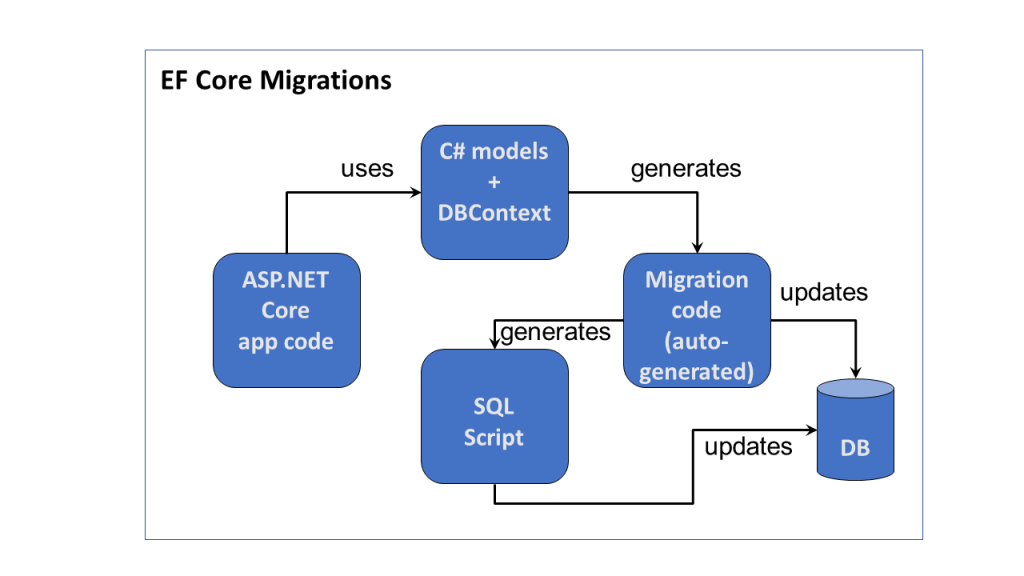
- #Updatedatabase command ef how to#
- #Updatedatabase command ef driver#
- #Updatedatabase command ef code#
- #Updatedatabase command ef zip#
- #Updatedatabase command ef windows#
#Updatedatabase command ef code#
There are primarily 2 ways of performing Code First Migrations,įor migrations, Entity Framework packs a set of commands which are executed from the Package Manager Console.
#Updatedatabase command ef how to#
Let’s see how to use code first migrations and update the database schema incrementally. For dealing with this, EF 4.3 released a special tool called Entity Framework Code First Migrations which allows us to manage the database changes that are changing continuously. As mentioned in the quick start guide, the database initializers are very basic and does not support incremental updations to database schema which is how we will manage database changes in real time. Until, EF 4.3, the only way to manage the database creation from Code First model is using the Database Initializers. Read the Quick Start Guide Learn Entity Framework Code First in 10 Minutes to have quick understanding on EF Code First approach.
#Updatedatabase command ef driver#
This is called Domain Driver Design, where the developers will define the domain model as POCO classes and the EF will create the database tables based on the POCO classes. While this example specifies the connection string directly, the connection string can also be stored as a configuration variable, in a configuration file, or omitted if the artifact already contains a configuration file (or one was deployed with Deploy-ConfigFile) with a valid connection string.Entity Framework Code First development helps us to define the domain model first and then delegate the database creation process to Entity Framework based on the domain model. Assuming it was captured in an artifact, the deployment plan only requires the following operations: Deploy-Artifact Database() Įxec ef6.exe database update -assembly -connection-string "Database=MyProject Server=us-db-stg-01 Integrated Security=true" To perform a migration in a BuildMaster deployment plan, simply use the Exec operation against ef6.exe. An optional -target migration name may specified, which will only run migrations up to and including the specified one by name. This command will run all migrations in the assembly against the MyProject database. To migrate a database from a compiled DLL that contains code-first migrations, an example command would be: ef6.exe database update -assembly -connection-string "Database=MyProject Server=us-db-stg-01 Integrated Security=true" This is likely the best solution if all the migrations are executed on the same server (regardless of the actual server the database is on or specified in the connection string).
#Updatedatabase command ef windows#
This can be accomplished in a build plan like this: NuGet::Restore-Packagesįrom: ~\src\packages\EntityFramework.\tools\\Īlternatively, you could store ef6.exe on the build server in a directory referenced in the Windows PATH.

Refer to the linked documentation for the arguments.įor ease of deployment, we recommend capturing the ef6.exe tool into a database build artifact alongside the DLL that contains the migrations. Prior to EF v6.3.0, the tool migrate.exe was used to perform migrations. Refer to the dotnet ef CLI documentation for more information on the specific arguments. Any commands that reference ef6.exe can be replaced with dotnet.exe ef, although the arguments are slightly different. NET Core applications do not require this tool, as it is included with the dotnet.exe CLI. zip, and extracting it from the tools// directory.
#Updatedatabase command ef zip#
zip files, the executable can be extracted directly from the package in Windows by downloading the package, changing the extension from. Because it is a standalone tool and NuGet packages are. The ef6.exe command line tool is found in the tools/ subfolder of the EntityFramework NuGet package. NET Core CLI tool, or the standalone tool ef6.exe.Īs an alternative to migrations, change scripts could be generated and executed using BuildMaster's built-in change script management process.

Migrations can be performed directly from Visual Studio, the. NET objects after the database schema is created) may be the best solution.īuildMaster is capable of deploying database changes resulting from changes to the ORM objects.

For those organizations, scaffolding (i.e., generating the. This process, known as a code first, can increase the development cycle in smaller organizations, but also introduce deployment challenges in larger organizations where specialized teams perform database deployments. NET applications, allowing devlopers to effectively build database schemas in any platform (e.g., SQL Server, MySQL, PostgreSQL) in C# or Visual Basic, as opposed to creating them by writing SQL directly. Entity Framework (EF) is Microsoft's ORM designed for.


 0 kommentar(er)
0 kommentar(er)
